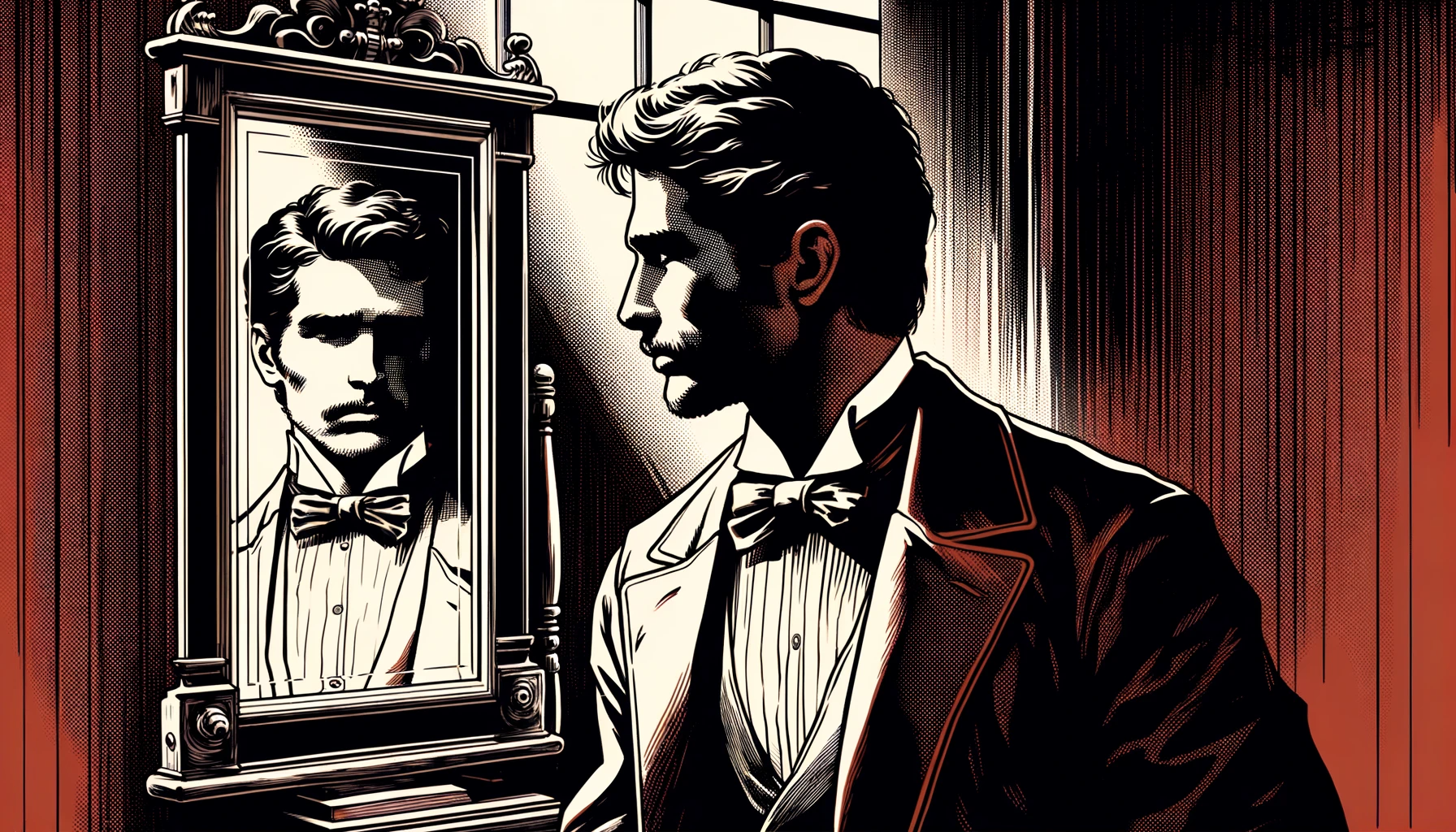Transforming Your Self-Image
Published by Ben Worrall 2nd February 2024

This is the second article in a two-part series on self-image. In the previous article, we discussed how your self-image has been formed through a lifetime of identifying with your beliefs and we addressed many of the ways self-image can influence your day-to-day behavior.
If you haven’t already, I’d recommend reading the previous article before continuing with this one as it lays the groundwork for what we’ll be covering here: The Hidden Influence of Self-Image (Part One)
We have already established that self-image influences how we conduct ourselves throughout life.
But can it be changed?
Keep in mind that your self-image has been with you for most of your life. It’s deeply ingrained in your behaviour. Trying to change it is like removing a mask that has become fused with your face. Your self-image is core to who you think you are and how others perceive you.
The good news is that self-image is just mental dust. It’s made up of thoughts and beliefs. Neither of which is fixed, and therefore, it can indeed be questioned and challenged.
Let’s explore some techniques that can help us in the process of modifying our self-image.
Modifying the Self-Image
Your first instinct will be to try to think your way out of it.
This is not going to work.
You can understand that the beliefs you hold about yourself are false. You can attempt to use willpower to change. But when a new unexpected situation arises your self-image will return in full force. It’s similar to a stretched elastic band that springs back to its original shape as soon as concentration lapses.
Here’s what you do instead.
Introduce new beliefs that are strong enough to replace the old ones.
To do this you’ll need to seek out new experiences that challenge your assumptions. They reframe your self-image by providing evidence to the contrary.
A Writer’s Self-Doubt
Mike is an aspiring writer who struggles with a pessimistic view of his ability to finish writing a book. This lack of belief in his writing has been a pattern throughout his adult life. He spends countless hours on the first few chapters, but soon enough his inner critic emerges from the darkness of his psyche and tears down his self-belief.
Mike’s constant self-criticism becomes so unbearable, that what was once an exciting new pursuit is stripped of all joy and passion. Before he knows it, the familiar feeling of dark despair creeps back in and he decides to scrap the project.
When Mike was around twelve years old, he was told that his writing wasn’t all that great — which may or may not have been true. But it sparked a downward spiral causing him to become increasingly focused on the flaws in his work.
As his self-doubt grew, more manuscripts found their way to the trash. These multiple failures reinforced his self-image as a terrible writer, who isn’t productive and who would never be able to produce something of quality.
Mike is held hostage by his negative self-image and subject to all the unfortunate consequences that emerge from his imaginings.
Reframing
The first step Mike should take is to reframe his situation. He needs to become aware that the ideas he holds about himself are just beliefs and nothing more. He should acknowledge that he is neither good nor bad, just a writer who is making slow and steady improvements. This is a much more realistic take on the situation.
Second, Mike needs to construct positive beliefs about himself through new experiences. One way to do this would be to forget about writing a book for now and return to simple projects that come with less pressure and judgment — writing articles or short stories for example.
By finishing these shorter projects, his negative beliefs lose their strength and his self-image is left starved of evidence to support it. It begins to fade.
The downward spiral reverses its course upwards. Over time he’s able to finish bigger projects and receive constructive feedback which also helps counter his negative beliefs. Eventually, this new self-image gives him the strength to finish writing his dream book.
Do you see how this works?
Doubt can be reduced by building a track record of success. All it takes is a series of counter experiences to reverse the negative spiral.
While this works for the writer, gaining new experiences that counter your beliefs is not always simple.
Indirect Change
Take someone with a confidence problem.
They believe that they’re not confident based on previous experience. Every time they find themselves in a situation demanding confidence, their deep-rooted beliefs cause them to act out their lack of confidence. Feedback from their environment confirms their initial beliefs. Their self-image is reinforced and the self-destructive behavior continues in the future.
This person needs to find a way to disrupt the cycle and change their self-image while avoiding experiences that contribute to negative interpretations.
The following are some strategies for doing this.
Visualization
One way to approach this issue is to use the power of visualization.
This involves taking advantage of the human knack for imagination:
Find somewhere comfortable. Close your eyes. Visualize a specific scenario that involves an aspect of your self-image you want to change. Once you have a behavioural change in mind, imagine yourself performing in a way that matches your desired outcome.
This could be interacting with the world with confidence, it could be behaving more lovingly, it could be learning to drive, playing an instrument, giving a lecture, being more disciplined, or any other number of possibilities.
“Your nervous system can’t tell the difference between an imagined and a real experience.” — Maxwell Maltz, Psycho-Cybernetics
It’s important to see yourself in a real-life situation and to experience it in as much detail as possible. Make sure to engage all the senses. The more real-to-life your visualizations are, the more likely they’ll have an impact on your daily activities.
If vivid enough, your subconscious mind will eventually process the imagined experience as if it were real, and thereby your real-life behaviour will begin to move in the desired direction without risking the possibility of reinforcing negative behaviour patterns.
Doing this once isn’t enough. You need to make it into a daily habit. It’s the consistent exposure to this new version of yourself which will begin to transform your self-image.
Negative Imagination
Keep in mind that visualization is a double-edged sword. It can be used to benefit or hurt you.
As we go about life we’re often using this process of imagination to reinforce the negative aspects of our self-image without realising what we’re doing or how harmful it is.
If you’re anything like me, you’re in the habit of visualizing the future and projecting negative experiences or worst-case scenarios. This is a dangerous mental pattern to fall victim to because it will have the opposite effect of positive visualization.
You teach your subconscious to act out the negative experience by imagining negative scenarios. You’re programming yourself to behave in the exact way you’re trying to avoid.
Playfulness
A big problem when we try to change our self-image is that it isn’t just made up of a collection of independent beliefs, but beliefs that reinforce each other to create an overall sense of identity.
You can challenge one belief, but ten others around it confirm its legitimacy. The structure takes on a rigid form which refuses your attempts to challenge individual beliefs — to maintain a consistent self-image.
One way to tackle this problem is to take a playful approach to change. Experiment with new ideas and possibilities rather than attempting to knock your entire identity down with a sledgehammer.
A playful approach is useful because it’s a non-threatening way to introduce new experiences. Treating change as an “act” permits you to behave out of character. You are opening the door to this new way of relating to the world and giving yourself a taste of how life would be different if you took on this new self-image permanently.
By experimenting with different versions of yourself, you can get a sense of how the world would react to this new version without putting your sense of self on the line.
If you want to try this, I’d recommend finding an aspect of your self-image you want to change, or a belief that you think is holding you back, and try acting in the opposite way.
For example, if you tend to be a people pleaser, spend some time completely disregarding the needs of others. Your instant reaction will most likely be to flinch away from this possibility, but try to keep the bigger picture in mind and remind yourself that it’s only an act; a temporary experiment. Have fun with it.
Don’t worry. Your personality won’t suddenly change into a monstrous shadow of its former self. Playing with options is just an opportunity to challenge your beliefs without the downside that comes with taking the process too seriously.
Realism & Balance
The goal is to maintain a healthy self-image that gives you the freedom to live your best life. If your self-image already works for you then there’s not much more to be done here. On the other hand, if you’re like most people, there will be issues that should be addressed.
The way to do this is to construct a new self-image with two specific qualities in mind: Realism and Balance.
Realism and balance are the overarching principles for working with your self-image. Yes, you want to develop a positive self-image that allows you to deal with life’s challenges, but you also want to keep it in the realm of who you are. It’s important to take a down-to-earth approach that doesn't over-inflate or under-inflate your self-worth.
An inflated self-image is often a direct response to insecurity. An unconfident person may become overbearing to compensate for their perceived lack. Someone insecure about their physical appearance will put more attention into making themselves appear attractive. An individual with perceived low value will place great importance on being the value provider.
By compensating for your perceived flaws you’re unconsciously reinforcing the duality between have and have not, be or not be. And here lies the problem.
You’ve fallen into the trap of believing there is a right or wrong way to behave. You’re measuring yourself on an imaginary scale while failing to understand that the world is made up of individuals with unique differences and quirks — read my essay on personality.
What does a healthy self-image look like then?
It’s the reconnection of polarising views about who you are. It’s an acceptance of yourself as a normal person with flaws just like everyone else. It’s an acknowledgement of where your strengths lie without relying on them to bolster your self-esteem. It’s a cleaning up of your perceptive window so you can relate to the world as honestly as possible.
You want to get to the point where you feel truly grounded and secure in your own identity.
Here are some tips for creating a healthy self-image:
Use visualization exercises to focus on areas that are out of balance.
Imagine scenarios that highlight your ability to be a normal, friendly, authentic, honest, and loving human.
Lower your expectations of yourself. You don’t need to be the best and you’re not going to be the worst. Somewhere in between is all you need to be aiming for.
As you work on refining your self-image, you might begin to question its purpose. Do we need a self-image? Or can we move beyond it?
Outgrowing the Self-Image
“The neurotic person is afraid to open himself up to love and to be fully himself.” — Alexander Lowen, Fear of Life
What we’ve been doing here is playing fantasy games.
That’s essentially what the self-image is — a fantasy.
For most people, constructing a healthy fantasy about themselves is a helpful tool to navigate life. The problems arise when this fantasy becomes unruly, and your priority should be to avoid that happening, which can be done using the methods discussed in this two-part series.
I do believe, however, that the true gold is waiting for the select few who manage to drop their self-image completely. Those who can fully embrace who they are in the moment without having to attach themselves to any specific image will be free to explore life on their terms and will be happier for it.
This is no easy feat and requires a self-love that goes beyond any specific identity measurement. It comes about from letting go of the conceptual baggage that keeps the small self at the forefront of the mind.
With a baggage-free mind, we’re able to move one step back and experience life from the vantage point of The Self.
The one beyond the self-image. The one that witnessed its creation.
But that’s a topic for another essay ;)
Ben Worrall





